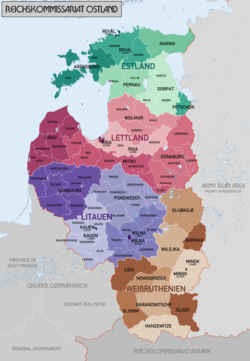
Reichskommissariat (English: Realm Commissariat ) is a German word for a type of administrative entity headed by a government official known as a Reichskommissar (English: Realm Commissioner ). Although many offices existed, primarily throughout the Imperial German and Nazi periods in a number of fields (ranging from public infrastructure and spatial planning to ethnic cleansing), it is most commonly used to refer to the quasi-colonial administrative territorial entity established by Nazi Germany in several occupied countries during World War II. While officially located outside the German Reich in a legal sense, these entities were directly controlled by their supreme civil authorities (the Reichskommissars), who ruled their territories as German governors on behalf of and as representatives of Adolf Hitler. [1]
Contents
The introduction of these territorial administrations served a number of purposes. Those established or planned to be established in Western and Northern Europe were in general envisioned as the transitional phases for the incorporation of Germanic countries outside pre-war Germany into an expanded Nazi state. [2] Their eastern counterparts served primarily colonialist and imperialist purposes, as sources of Lebensraum for German settlement and the exploitation of natural resources. [3] [4]
Another contrast was the level of administrative overhaul implemented in these two types. As in most other territories conquered by the Germans, local administrators and bureaucrats were pressured to continue their regular day-to-day operations (especially at the middle and lower levels) albeit under German oversight. Throughout the war, the Reichskommissariats in Western and Northern Europe retained the existing administrative structure, while in the eastern ones, new structures were introduced. [5] All of these entities were intended for eventual integration into a Greater Germanic Reich (German : Großgermanisches Reich) encompassing the general area of Europe stretching from the North Sea to the Ural Mountains, for which Germany was to form the basis. [2]
